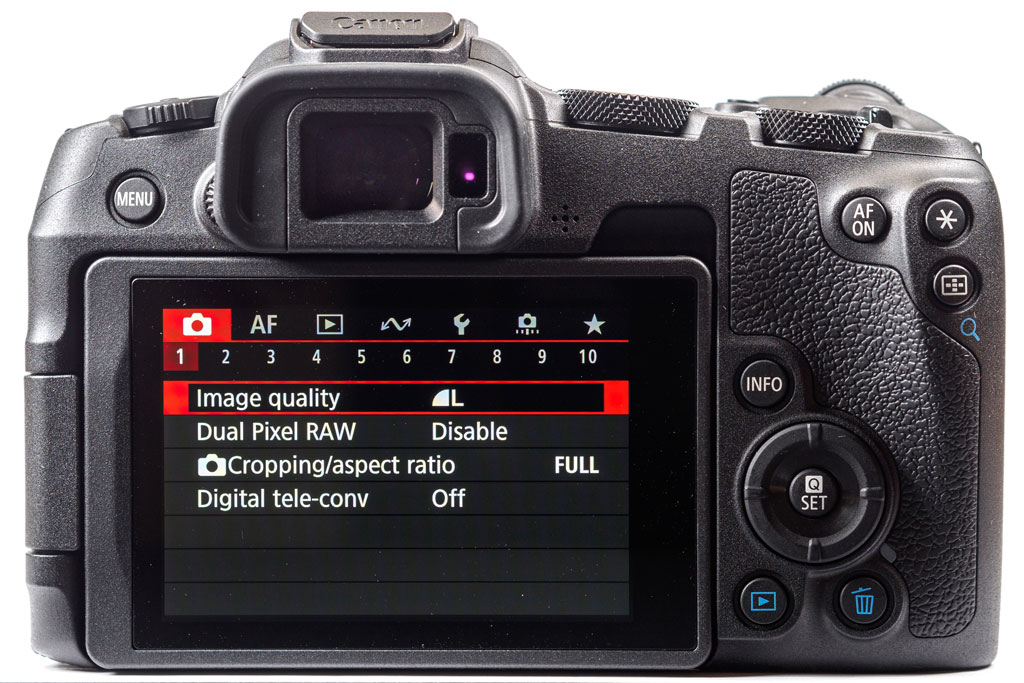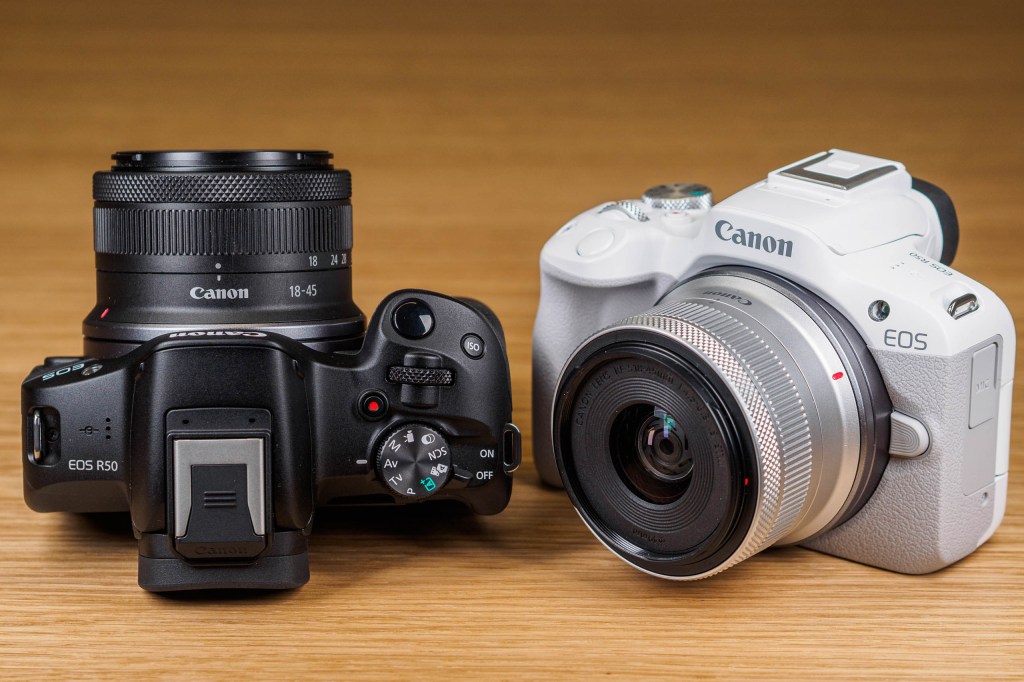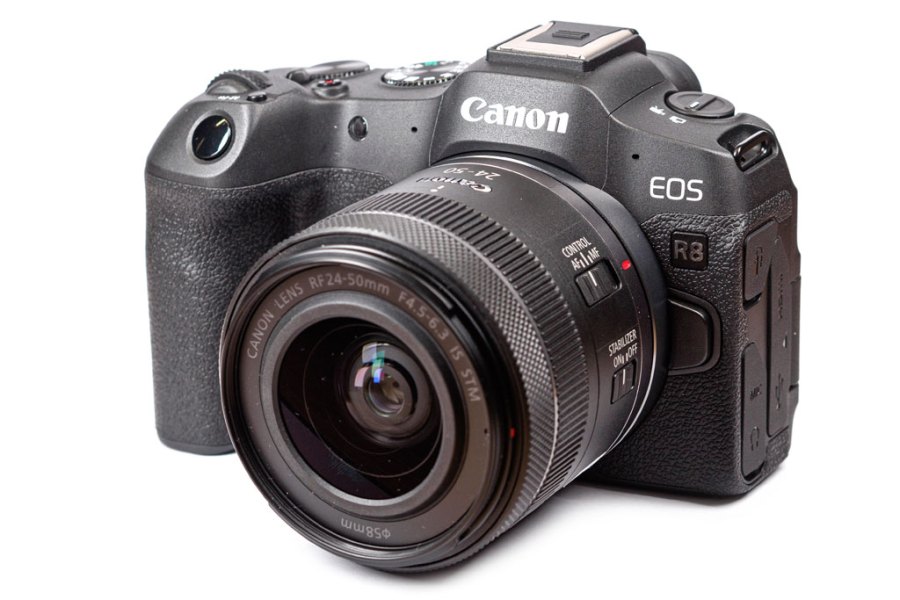New entry-level full-frame Canon EOS R8 combines 24MP sensor from the EOS R6 Mark II with body based on EOS RP
Canon has announced a new full-frame mirrorless camera that it says is its lightest yet. The EOS R8 is based on the existing EOS RP body design, but employs the same 24MP sensor and image processor as the recently launched EOS R6 Mark II. It also gains a new lightweight, collapsible kit zoom, the Canon RF 24-50mm F4.5-6.3 IS STM.
Core photographic features include a standard sensitivity range of ISO 100-102,400 and continuous shooting at up to 40 frames per second. There’s an array of scene modes for beginners, alongside the full set of manual control options for more advanced users.
Subject detection AF is included, with human eye, face, head, and body detection. The camera can also recognise and focus specifically on animals including cats, dogs, horses and birds, and vehicles including cars, bikes, trains and aircraft. As with other recent Canon cameras, AF tracking is available in all modes.

From the back, the camera looks practically identical to the EOS RP. Image credit: Andy Westlake
Video recording is available at 4K resolution and 60 fps, or Full HD and 120fps. Both Wi-Fi and Bluetooth are built-in for connection to a smartphone via the Canon Camera Connect app, and unusually, the EOS R8 can also work with a wired connection via its USB-C port, with Apple MFI certification for use with iPhones.
Design-wise, the camera is extremely similar to the current EOS RP, but with the addition of a new switch for selecting between stills and video mode. Otherwise, it uses the same small, lightweight body with a simple control layout. There’s a central electronic viewfinder and a fully articulated LCD.
The Canon EOS R8 is due to go on sale in March. It’ll be available either body-only for £1700, or £1900 in a kit with the RF 24-50mm F4.5-6.3 IS STM zoom. This lens will also be available separately for £380.
We got our hands on the R8 for a first look prior to its launch – follow the link below to read our initial impressions.

Read our Canon EOS R8 Hands-on First Look
Also announced at the same time is the Canon EOS R50 – a compact, entry-level APS-C model with an RF-mount.

Read our Canon EOS R50 hands-on first look
Follow AP on Facebook, Twitter, Instagram, and YouTube.
From Canon:
Canon launches its lightest full frame EOS R System camera

EOS R8 gives photographers the tools they need to step up creativity with full frame
London, United Kingdom, 8th February 2023 – Canon Europe announces the EOS R8, a new full frame mirrorless camera, which inherits technology from the feature-packed EOS R6 Mark II. With a compact design similar to the EOS RP, this powerful combination gives photo/ video enthusiasts and students the tools they need to make the leap with their passion.
Featuring a 24.2 megapixel full frame CMOS sensor, high ISO and improved dynamic range, the EOS R8 is the ideal choice for portrait, event and landscape photography delivering a wider, more artistic perspective. Accompanied by the launch of the RF 24-50mm F4.5-6.3 IS STM, a small lightweight RF series zoom lens, the pair create a compact yet powerful kit bag allowing photographers to explore creativity in full frame.
Full frame quality in a lightweight body
Offering all the benefits of full frame image quality, the EOS R8 features a 24.2 megapixel full frame CMOS sensor capable of achieving the same resolution as the EOS R6 Mark II. The class leading sensor offers a fast read out speed to unlock a number of advanced features including a reduced rolling shutter that enables 40fps continuous shooting and low noise high ISO up to 102,400. This makes the EOS R8 perfect for shooting in environments which are dimly lit in which subjects are moving around. Improved dynamic range also enables capture of striking images with bold colours and the full frame sensor offers shallower depth of field that creates a soft background to help the subject stand out.
Weighing approx. 461g (with card and battery), the EOS R8 is Canon’s lightest full frame EOS R System camera to date. Measuring 132.5 x 86.1 x 70mm the camera has similar dimensions to the EOS RP, with a number of additional professional level features contained in its compact body. The EOS R8 has a high resolution 2.36m dot EVF working at up to 120fps and UHS-II SD card support. The intuitive interface makes the camera easy to operate on the go with a useful mode dial featuring 12 modes across still and video shooting and a dedicated switch for moving between photo and movie capture.
Capture life in motion
The advanced sensor of the EOS R8 captures full width 4K 60p footage that is oversampled from 6K sensor data for sharp, detailed video content, as well as 180fps Full HD recording for slow motion videos. To support those wanting to upskill in video, this camera supports Canon Log 3 at 10-bit YCbCr 4:2:2 H.265 internal recording which offers greater dynamic range and more flexibility in post production. Alternatively, HDR PQ and HDR Movie modes can be selected to suit those with a HDR workflow and produces a clean HDMI output to compatible devices.
To combat focus breathing during movie recording, the EOS R8 has a function that compensates for changes to the angle of view when adjusting the focus distance. The camera also gives extended recording times for up to two hours of normal video shooting1, ideal for capturing vlogs or shooting at events.
Featuring the same Dual Pixel CMOS AF II as the EOS R6 Mark II, the EOS R8 focuses in as little as 0.03 seconds2even at 40fps with the electronic shutter. This intelligent system detects and tracks a range of subjects including animals, vehicles and people, offering head, face and eye detection for precision focus. For greater control, it is even possible to select which eye to prioritise. To simplify detection across such a broad range of subjects, users can choose the auto setting which selects the subject based on the composition of the image. This performance extends to low light shooting scenarios as low as -6.5 EV3.
Enhanced connectivity
With built in 2.4GHz Wi-Fi® and Bluetooth® connectivity4 users can easily share their work and make use of the Camera Connect app, while the WPA/WPA2/WPA3-Personal authentication ensures a secure connection. For iPhone owners, the EOS R8 is iOS MFI certifiedTM 5 making direct download and operation possible. The EOS R8 can be used as a webcam with its USB video device class (UVC)/ USB audio device class (UAC) support. Users with an image.canon subscription can leverage the Neural Network Image Processing Tool6 for advanced noise and moiré reduction that achieves natural looking JPEG and HEIF images.
Canon has also made updates to image.canon, expanding its use to a number of new users with Adobe® Lightroom® movie and corporate support enabling compatibility with a range of services including Frame.io and Google Photo accountsTM 7.
A small, light, everyday zoom
The RF 24-50mm F4.5-6.3 IS STM is a small and lightweight lens with a 2x zoom and 24-50mm focal length, a great choice for improving photography and video skills particularly when shooting portraits, interiors or travel. It offers advanced image stabilisation up to 4.5 stops which increases to 7 stops when attached to an EOS R camera with IBIS, meaning creators and photographers can shoot video and stills in low light without the need for a tripod. The STM focusing motor is fast and quiet, with extra control from a customisable lens control ring that lets users switch between different modes so they can shoot and film like a Pro. Benefitting from the RF Mount, the RF 24-50mm F4.5-6.3 IS STM works with EOS R Series cameras to support a wide range of in-camera image enhancement features including panning in scene mode and focus breathing correction for movies.
Further details about the EOS R8 are available here: www.canon.co.uk/cameras/eos-r8/ and the RF 24-50mm F4.5-6.3 IS STM here: www.canon.co.uk/lenses/rf-24-50mm-f4.5-6.3-is-stm/
1 Up to 5 seconds pre-record possible. If the camera’s internal temperature becomes too high the recording time may reduce. Shooting 4K UHD 59.94p for approx. 30 minutes without heat limit is possible if starting from +23°C. In other modes there is no limit due to heat.
2 Correct as of 8th February 2023. Based on CIPA guidelines, using an internal measurement method. At a focusing brightness of EV 12 (ISO 100), at room temperature, in M mode, with RF 24-105mm F4-7.1 IS STM, shooting still photos with the shutter button, 1-point AF (centre AF point), and One-Shot AF.
3 With an f/1.2 lens, centre AF point, and One-Shot AF, at 23°C / 73°F and ISO 100.
4 Equipped with Bluetooth® low energy technology. The Bluetooth® word mark and logos are registered trademarks owned by the Bluetooth SIG, Inc. and any use of such marks by Canon Europe Ltd. is under license. Other trademarks and trade names are those of their respective owners. Wi-Fi® is a registered trademark of the Wi-Fi Alliance. The Bluetooth® word, mark and logos are registered trademarks owned by the Bluetooth SIG, Inc. and any use of such marks by Canon Inc. is under license. Other trademarks and trade names are those of their respective owners.
5 Apple, Apple TV, Apple Watch, iPad, iPad Air, iPad Pro, iPhone, and Lightning are trademarks of Apple Inc., registered in the U.S. and other countries. tvOS is a trademark of Apple Inc. iPhone is trademark of Apple Inc., registered in the U.S. and other countries. IOS is a trademark or registered trademark of Cisco in the US and other countries and is used under licence. QR Code is registered trademark of DENSO WAVE INCORPORATED.
6 Image.canon app and subscription is free, however the cloud raw image processing is a subscription based charged service that requires separate subscription on sas.image.canon. Canon’s Neural Network Image Processing Tool is available through DPP as part of the post processing workflow on a computer, or Neural Network Image Processing by image.canon that can be done straight from camera.
7 Google Play and Android are trademarks of Google LLC.







